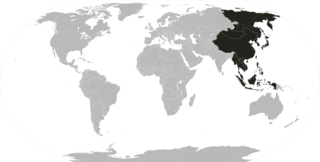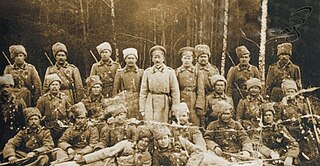
The Far East was a European term to refer to the geographical regions that includes East and Southeast Asia as well as the Russian Far East to a lesser extent. South Asia is sometimes also included for economic and cultural reasons.

Siberia is an extensive geographical region, constituting all of North Asia, from the Ural Mountains in the west to the Pacific Ocean in the east. It has been a part of Russia since the latter half of the 16th century, after the Russians conquered lands east of the Ural Mountains. Siberia is vast and sparsely populated, covering an area of over 13.1 million square kilometres (5,100,000 sq mi), but home to merely one-fifth of Russia's population. Novosibirsk, Krasnoyarsk and Omsk are the largest cities in the region.

Khabarovsk Krai is a federal subject of Russia. It is geographically located in the Russian Far East and is a part of the Far Eastern Federal District. The administrative centre of the krai is the city of Khabarovsk, which is home to roughly half of the krai's population and the largest city in the Russian Far East. Khabarovsk Krai is the fourth-largest federal subject by area, and has a population of 1,343,869 as of 2010.

Amur Oblast is a federal subject of Russia, located on the banks of the Amur and Zeya Rivers in the Russian Far East. The administrative center of the oblast, the city of Blagoveshchensk, is one of the oldest settlements in the Russian Far East, founded in 1856. It is a traditional center of trade and gold mining. The territory is accessed by two railways: the Trans-Siberian Railway and the Baikal–Amur Mainline. As of the 2010 Census, the oblast's population was 830,103.

The Russian Far East is a region in Northeast Asia. It is the easternmost part of Russia and the Asian continent; and is administered as part of the Far Eastern Federal District, which is located between Lake Baikal in eastern Siberia and the Pacific Ocean. The area's largest city is Khabarovsk, followed by Vladivostok. The region shares land borders with the countries of Mongolia, China, and North Korea to its south, as well as maritime boundaries with Japan to its southeast, and with the United States along the Bering Strait to its northeast.

The Far Eastern Republic, sometimes called the Chita Republic, was a nominally independent state that existed from April 1920 to November 1922 in the easternmost part of the Russian Far East. Although theoretically independent, it largely came under the control of the Russian Soviet Federative Socialist Republic (RSFSR), which envisaged it as a buffer state between the RSFSR and the territories occupied by Japan during the Russian Civil War of 1917–1922. Its first president was Alexander Krasnoshchyokov.

Buryatia, officially the Republic of Buryatia, is a republic of Russia located in Siberia. It is the historical native land of indigenous Buryats. Formerly part of the Siberian Federal District, it has been a part of the Russian Far East since 2018. Its capital is the city of Ulan-Ude, which means Red Gateway in Buryat Mongolian. Its area is 351,300 square kilometers (135,600 sq mi) with a population of 978,588.

The deportation of Koreans in the Soviet Union was the forced transfer of nearly 172,000 Soviet Koreans (Koryo-saram) from the Russian Far East to unpopulated areas of the Kazakh SSR and the Uzbek SSR in 1937 by the NKVD on the orders of Soviet leader Joseph Stalin and Chairman of the Council of People's Commissars of the Soviet Union Vyacheslav Molotov. 124 trains were used to resettle them 6,400 km to Central Asia. The reason was to stem "the infiltration of Japanese espionage into the Far Eastern Krai", as Koreans were at the time subjects of the Empire of Japan, which was the Soviet Union's rival. However, some historians regard it as part of Stalin's policy of "frontier cleansing". Estimates based on population statistics suggest that between 16,500 and 50,000 deported Koreans died from starvation, exposure, and difficulties adapting to their new environment in exile.

UTC+09:00 is an identifier for a time offset from UTC of +09:00.

Russophilia is admiration and fondness of Russia, Russian history and Russian culture. The antonym is Russophobia. In the 19th Century, Russophilia was often linked to variants of Pan-Slavism, since the Russian Empire and the autonomous Serbia were the only two slav-associated sovereign states during and after Spring of Nations.

Japan–Russia relations or Japanese–Russian relations are the bilateral international relations between Japan and the Russian Federation. Relations between Russia and Japan are the continuation of the relationship of Japan with the Soviet Union from 1917 to 1991, and with the Russian Empire from 1855 to 1917. Historically, the two countries had cordial relations until a clash of territorial ambitions in the Manchuria region of northeastern China led to the Russo–Japanese War in 1904, ending in a Japanese victory which contributed to the weakening of the monarchy in Russia. Japan would later intervene in the Russian Civil War from 1918 until 1922, sending troops to the Russian Far East and Siberia. That was followed by border conflicts between the new Soviet Union and the Empire of Japan throughout the 1930s. The two countries signed a nonaggression pact in 1941, although the Soviet government declared war on Japan anyway in August 1945, invading the Japanese puppet state of Manchukuo as well as seizing the Kuril chain of islands just north of Japan. The two countries ended their formal state of war with the Soviet–Japanese Joint Declaration of 1956, but as of 2022 have not resolved this territorial dispute over ownership of the Kurils.

The Soviet–Japanese War, known in Mongolia as the Liberation War of 1945, was a military conflict within the Second World War beginning soon after midnight on 9 August 1945, with the Soviet invasion of the Japanese puppet state of Manchukuo. The Soviets and Mongolians ended Japanese control of Manchukuo, Mengjiang, northern Korea, Karafuto, and the Chishima Islands. The defeat of Japan's Kwantung Army helped bring about the Japanese surrender and the termination of World War II. The Soviet entry into the war was a significant factor in the Japanese government's decision to surrender unconditionally, as it was made apparent that the Soviet Union was not willing to act as a third party in negotiating an end to hostilities on conditional terms.

East Asia is the eastern region of Asia, which is defined in both geographical and ethno-cultural terms. The modern states of East Asia include China, Japan, Mongolia, North Korea, South Korea, and Taiwan. China, North Korea, South Korea and Taiwan are all unrecognised by at least one other East Asian state due to severe ongoing political tensions in the region, specifically the division of Korea and the political status of Taiwan. Hong Kong and Macau, two small coastal quasi-dependent territories located in the south of China, are officially highly autonomous but are under Chinese sovereignty. Japan, Taiwan, South Korea, Mainland China, Hong Kong, and Macau are among the world's largest and most prosperous economies. East Asia borders Siberia and the Russian Far East to the north, Southeast Asia to the south, South Asia to the southwest, and Central Asia to the west. To the east is the Pacific Ocean and to the southeast is Micronesia.

Vladivostok is the largest city and the administrative center of Primorsky Krai, Russia. The city is located around the Golden Horn Bay on the Sea of Japan, covering an area of 331.16 square kilometers, with a population of 600,871 residents as of 2021. Vladivostok is the second-largest city in the Far Eastern Federal District, as well as the Russian Far East, after Khabarovsk.

Calamotropha is a genus of moths of the family Crambidae.

The Battle of Volochayevka was an important battle of the Far Eastern Front in the latter part of the Russian Civil War. It occurred on February 10 through 12, 1922, near Volochayevka station on the Amur Railway, on the outskirts of the city of Khabarovsk.

The Donetsk People's Republic is a disputed entity created by Russian-backed separatists in eastern Ukraine, which claims Donetsk Oblast. It began as a breakaway state (2014–2022) and was then annexed by Russia in 2022. The city of Donetsk is the claimed capital city.
Calamotropha fulvifusalis is a moth in the family Crambidae. It was described by George Hampson in 1900. It is found in Amur and Ussuri in the Russian Far East and Honshu and Hokkaido in Japan.

The Chita Operations were a series of military engagements fought in the Russian Civil War. On 10 April 1920, the army of the Far Eastern Republic (FER) launched the first operation, aiming at destroying the White Movement's Chita holdup in east Transbaikal which prevented it from connecting with its allies in Primorsky Krai. The first operation ended three days later, a second offensive likewise failed to achieve its final objectives. Fighting continued, however neither side could boast significant territorial gains. On 15 July, the FER signed the Gongota Agreement of 1920 with Japan, the latter's withdrawal from Transbaikal severely weakened the Whites. The FER army was restructured and reinforced by its new commander Genrich Eiche, while morale under Grigory Semyonov's White units plummeted. On 1 October, Eiche launched the final Chita operation, by the end of the month the area of the Chita holdup had been subjugated.
During the 1920s and 1930s the Soviet government forcibly transferred thousands of Chinese nationals and ethnic Chinese Soviet citizens from the Russian Far East, Most of the deportees were relocated to the Chinese province of Xinjiang and Soviet-controlled Central Asia. Although there were more than 70,000 Chinese living in the Russian Far East in 1926, the Chinese had become almost extinct in the region by the 1940s. To date, the detailed history of the removal of Chinese diasporas in the region remains to be uncovered and deciphered from the Soviet records.

















